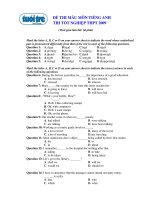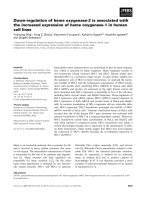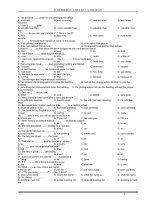Bài thi mẫu môn phonetics and phonology
Bạn đang xem bản rút gọn của tài liệu. Xem và tải ngay bản đầy đủ của tài liệu tại đây (114.07 KB, 3 trang )
1. Auditory phonetics is concerned with the ...
A. production of phonetic sounds of words of a language
B. hearing of phonetic sounds of words of a language
C. transmission of phonetic sounds of words of a language
D. description of phonetic sounds of words of a language
2. The lowest part of the tongue in the throat is called the …
A. epiglottis
B. tongue root
C. dorsum
D. tongue blade
3. In a ....... consonant, the lower and upper lips approach or touch each other.
A. dental
B. labiodental
C. bilabial
D. palatal
4. Which of the following groups contains a segment that differs in
manner of articulation from the other segments?
A. [ p , b , t , d ] B. [ t , b, k , g ] C. [ f, v, s, z ]
D. [ m, ŋ , n, z,
]
5. Which of the following statements is correct?
A. Fricatives are consonants produced with a continuous airflow through the mouth.
B. Fricatives are consonants produced with the complete stoppage of the air in the mouth
which causes an explosion.
C. Fricatives are consonants produced with the lowering of the soft palate.
D. Fricatives are non-continuant consonants.
6. Which of the following is the stress distribution for the word artificial as in this context:
Please give him artificial respiration.?
A. [ a:tifi’∫l ]
B. [ a:’tifi∫l ]
C. [ a:ti’fi ∫l ]
D.[,a:ti ‘fi∫l ]
7. Which of the following phonetic variations may happen to the voiced stop [ d ] in this
context : [ li:d ] lead?
A. [ d ] is aspirated after the front vowel [i:]
B. [ d ] is devoiced after the long vowel [i:]
C. [ d ] is devoiced word finally
D. [ d ] is aspirated in the final position of a stressed syllable
8. Which of the following symbols that corresponds to each of the following phonetic
description:
voiced labiodental fricative
A. [ f ]
B. [ w ]
C. [ ð ]
D. [ v ]
9. Contrastive distribution is an indication that the two sounds in question are ...
A. different phonemes
B. allophones of the same phoneme
C. different phones
D. similar phonemes
10. Which of the following is a minimal pair ?
A. [ ð ] [ bet ] there - bet
B. [ dæb] [ bæd ] dab - bad
C. [ bæd ] [ bet ] bad - bet
D. [ ð ] [ d ] there - dare
11. The core or essential part of a syllable is called the ...
A. rhyme
B. onset
C. nucleus
D. coda
12. In the following transcriptions, a dot [.] represents a potential syllable boundary. Which
one shows the syllable boundary in the correct location for the word melting?
A. [ mɛl . tɪŋ ]
B. [ mɛlt . ɪŋ ]
C. [ mɛ . ltɪŋ ]
D. [ mɛltɪ . ŋ ]
13. Pairs of words which differ in one sound only and have different meanings are called ...
A. near minimal pairs
B. close pairs
C. minimal pairs
D. different pairs
14. Which of the following are described as [+ vocalic]?
A. Obstruent
B. Glides
C. Vowels
D. Liquids
15. ........... represent the placement of the body of the tongue.
A. Dorsal features
B. Laryngeal features
C. Place features
D. Manner features
16. The word 'tomato' consists of ......
A. two syllables
B. three syllable
C. one syllables
D. four syllables
17. Which of the following word lists has different vowels?
A. carpet, bath, hearth, aunt
B. sought, tough, cough, could
C. suit, shoe, rule, route
D. push, wolf, should, pull
18. A phonetic transcription is also called a....
A. phonemic transcription
B. broad transcription
C. narrow transcription
D. detail transcription
19. Which of the following is the description of the sound /i:/?
A. A more retracted front, short, lax, unrounded vowel
B. A front, short, lax, unrounded vowel
C. A lowest, front, short, lax, unrounded vowel
D. A front, close (high), long, tense, unrounded vowel
20. The place of articulation for /f/ is ___________.
A. Bilabial
B. Interdental
C. Alveolar
D. Labiodental
21. Which of the following words has a dipthong?
A. Neck
B. Get
C. Shut
D. Pie
22. Patterns of consonants and vowels for the word "green" = ...................
A. CCVC
B. CVCC
C. CCVCC
D. CVCV
23. The phrase is [juwənmi] in phonemic transcription is
A. He and you
B. You and me
C. You and mine
D. you and we
24. Which words are content words?
A. nouns
B. prepositions
C. articles
D. conjunctions
25. Which words are structure words?
A. adjectives
B. nouns
C. auxiliaries
D. verbs
26. Where is the stress of the word “economy”?
A. on the first syllable
B. on the second syllable
C. on the third syllable
D. on the last syllable
27. Which of the following coarticulation processes may happen to the alveolar / n / in this
context : [ krænbri ] cranberry ?
A. [ n ] may be devoiced before the voiced [ b ]
B. [ b ] may become syllabic after the nasal [ n ]
C. [ n ] may be labialized before [ b ]
D. [ b ] may be nasalized after [ n ]
28. Which of the following groups contains a segment that differs in shapes of lips (lip
rounding) from the other segments?
A. /ʊ/
B. /ɔ:/
C. /ɒ/
D. /e/
29. Which word below possibly shows the deletion of the schwa sound /ə/ in spoken English?
A. term
B. interesting
C. singer
D. employer
30. Which word does not have the aspirated [p]?
A. payment
B. happening
C. hippo
D. stop
31. …………is a sound change in which some phonemes change to become more similar to
other nearby sounds.
A. Derivation
B. Co-articulation
C. Dissimilation
D. Assimilation
32. Which of the following are the most vowel-like consonants?
A. nasals
B. glides
C. stops
D. fricatives
33. Which of the following coarticulatory processes that takes place in this pronunciation
context: ask [aks]
A. epenthesis
B. assimilation
C. metathesis
D. segment insertion
34. Which of the following phonological processes that takes place in the pronunciation of
“Would you?”
A. mutual assimilation
B. segment deletion
C. liason
D. dissimilation
35. Vowels followed by nasal consonants are……………
A. Lengthened
B. Devoiced
C. Shortened
D. Nasalized
36. Which of the following is not included in the criteria to classify English vowels?
A. Place of articulation
B. Tongue height
C. Lip shape
D. Muscle tension
37. A vowel is …………… when preceding a final fortis sound
A. Devoiced
B. Nasalized
C. Shortened
D. None of the above
38. Which of the following pairs of words have different diphthongs?
A. mare - prayer
B. dough – plough
C. aisle - dyke
D. ace - gaol
39. Which of the following statements is NOT correct?
A. The rhyme may consist of only the nucleus.
B. The rhyme never precedes the onset.
C. The rhyme may consist of a nucleus and a coda.
D. The rhyme may consist of an onset and a nucleus.
40. Which of the following symbols that corresponds to each of the following phonetic
description:
long mid back vowel
A. [ ɔ: ]
B. [ a: ]
C. [ i: ]
D. [ u: ]
----- THE END -----









